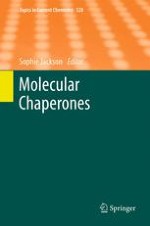2013 | OriginalPaper | Buchkapitel
Allostery in the Hsp70 Chaperone Proteins
verfasst von : Erik R. P. Zuiderweg, Eric B. Bertelsen, Aikaterini Rousaki, Matthias P. Mayer, Jason E. Gestwicki, Atta Ahmad
Erschienen in: Molecular Chaperones
Verlag: Springer Berlin Heidelberg
Aktivieren Sie unsere intelligente Suche, um passende Fachinhalte oder Patente zu finden.
Wählen Sie Textabschnitte aus um mit Künstlicher Intelligenz passenden Patente zu finden. powered by
Markieren Sie Textabschnitte, um KI-gestützt weitere passende Inhalte zu finden. powered by
